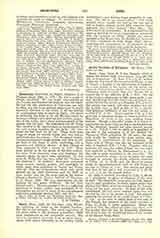

Anise (Matt., xxiii, 23) has been, since Wyclif, the rendering of annthon in the English Versions, But this is not accurate. The exact equivalent of the plant annthon is dill (anethum graveolens), while anise corresponds to the pimpinella anisum. The error in translation, however, is of no great importance, both plants belonging to the parsley family (umbelliferoe), and sharing many properties in common. The dill is an annual plant, “with finely striated stems, usually one foot to one foot and a half in height, pinnate leaves with setaceous linear segments, and yellow flowers” (Enc. Bib.). The Jews used it as a condiment. It is mentioned several times in Rabbinic literature, especially in connection with the question of tithes. Beside the articles specified in the Mosaic Law, the Rabbis had, in course of time, subjected to tithe many other objects, extending the prescription to all products of the earth that were esculent and could be preserved.
EDWARD ARBEZ

